Oradour-sur-Glane Fairgrounds
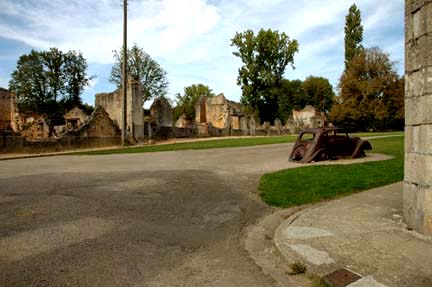
Around 2:15 p.m. on a beautiful Saturday
afternoon, the 10th of June 1944, all the people living in the
village of Oradour-sur-Glane, and others from the farming hamlets
south of the village, were ordered from their homes and forced
to assemble on the Fairgrounds by Waffen-SS soldiers in the elite
German army which had invaded the peaceful town. The photo above
shows the entrance to the Fairgrounds, located off Rue de Emile
Desourteaux. The old car belonged to Dr. Jacques Desourteaux,
who returned from his rounds just as the villagers were being
lined up, ostensibly to check their identity papers.
The Fairgrounds, with the rusty old car
slowly sinking into the ground, is the most photographed spot
in the ruined village. The photo below, which shows Rue de Emile
Desourteaux in the background on the left and the Beaulieu garage
on the right, behind the car, was taken early on a foggy morning
before the tourists arrived.
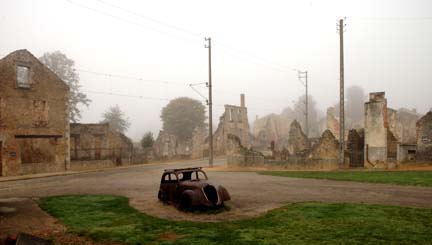
The photo below shows the ruined buildings
on the side opposite the car. The men of the village were lined
up in three rows and told to sit on the grass of the fairgrounds,
facing a wall on this side. Robert Hebras, one of the 5 men who
survived the massacre, wrote that "...during the events
leading up to the massacre, I did not sense the slightest sign
of brutality on the part of the Germans."
The SS commanding officer, Major Adolf
Diekmann, had asked the mayor, Dr. Paul Desourteaux, to choose
hostages; he offered himself and his four sons, including Dr.
Jacques Desourteaux, but this offer was declined. Hubert Desourteaux,
one of his sons, was among the survivors; he was an escaped POW
and he had the good sense to hide while the people were being
assembled. Nineteen year old Andre Desourteaux, the grandson
of Dr. Paul Desourteaux, also survived; he was a postal worker
in Limoges who lived in the village.
According to Sarah Farmer, in her book
"Martyred Village," Andre Desourteaux joined the Maquis,
as the French Resistance was called, at the end of June, following
the massacre, and after the Liberation of France in August 1944,
he joined the French Army.
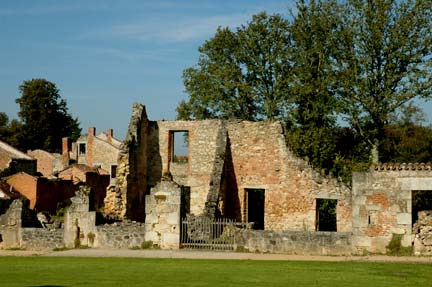
The photo below shows a sign on one of
the buildings on the other side of the fairgrounds, the side
nearest the car. The sign tells visitors that this is the place
where the population was assembled. In the background of the
photo is the remains of the Laudy barn.

On the side of the Fairgrounds across
from the car is the house shown in the photo below. I was intrigued
by this house; I kept returning to it again and again. I stopped
to rest here for a long time, sitting on the wall to the left
of the gate. What a delightful place to live, right on the village
green, near the town well, in an idylic rural community in France,
surrounded by peaceful neighbors, and far removed from the activity
of the French resistance in World War II. Notice the electrical
wiring going into the wall of the house on the left side. This
is a very small house, but beatifully constructed, and it has
a nice yard, which is shown in the second photo below.
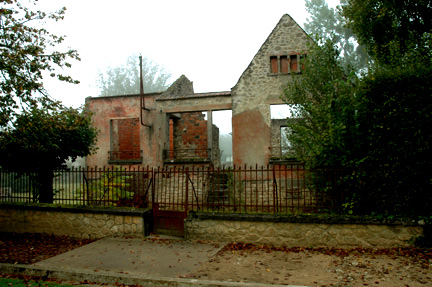

There were at least two survivors whose
homes faced the Fairgrounds. One of them was Monsieur Faure and
the other was Armond Senon, who hid because he had a broken leg,
sustained in playing a game of soccer. Gabriel Senon, the postmaster,
also survived.
Life went on as usual in this rustic
French village in the Summer of 1944, despite the battles raging
on all sides, since the villagers had nothing to do with the
Communist Resistance movement that was desperately trying to
defeat the Nazis and liberate Europe. I would like to think that
the person who lived in this house was among the survivors.
Among the 642 people who were massacred
in Oradour-sur-Glane on 10 June 1944 were 393 people living there,
including long-time residents and 84 refugees, according to Sarah
Farmer, who wrote a book called "Martyred Village,"
first published in 1999. The refugees included 26 Communist loyalists
who had fought in the Spanish Civil War which ended in 1939.
Also among the victims were 167 people
from the surrounding hamlets, including many school children
who were in the village that day for a medical exam. There were
33 people from Limoges who were visiting the village and 25 others
who were visiting from other towns; all were killed along with
the inhabitants of the village. There were 80 residents who survived
in one way or another, according to Sarah Farmer's book. Of these
80, there were 36 who were gone for the day and 28 who hid in
their homes or gardens and did not go to the Fairgrounds that
day. There were 5 men and 1 woman who survived the shooting of
the villagers, including 2 men in the Laudy barn who were not
wounded. The other 10 survived by some unknown way.
The photo below shows the far end of
the Fairgrounds. On the left is part of the Laudy barn, and on
the right is one of the many wells in the village. The Fairgrounds
ends at the road to the cemetery which is shown in the second
photo below.
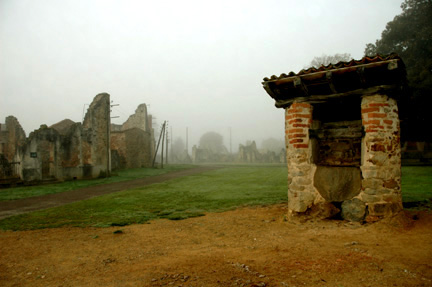

The photo above shows the far end of
the Fairgrounds with the road to the cemetery on the right.
According to an exhibit in the Center
of Memory, General Charles de Gaulle, head of the provisional
French government, visited the ruins in March 1945 and paid his
respects to the victims. "From this moment on Oradour was
to hold a special place in the collective memory of the French."
The preservation of the ruins began in the fall of 1944 and in
1946 a law was passed which guaranteed that the ruins would remain
"as found."
|